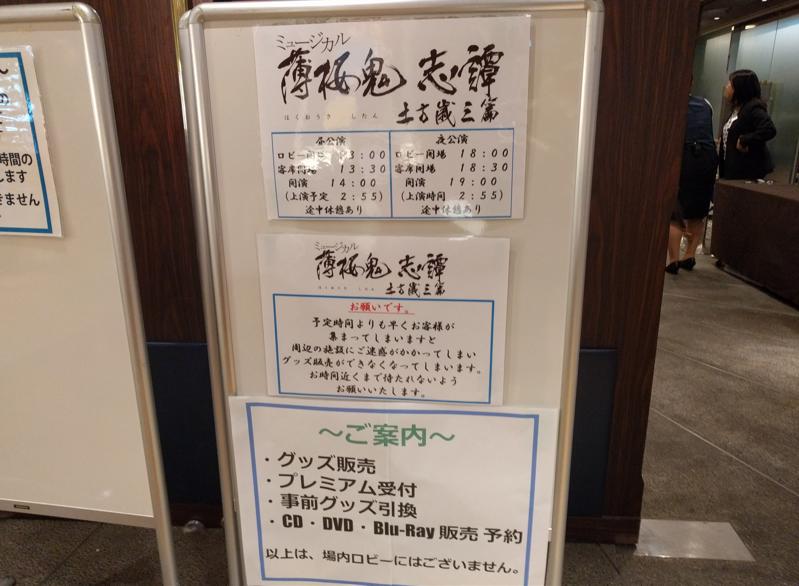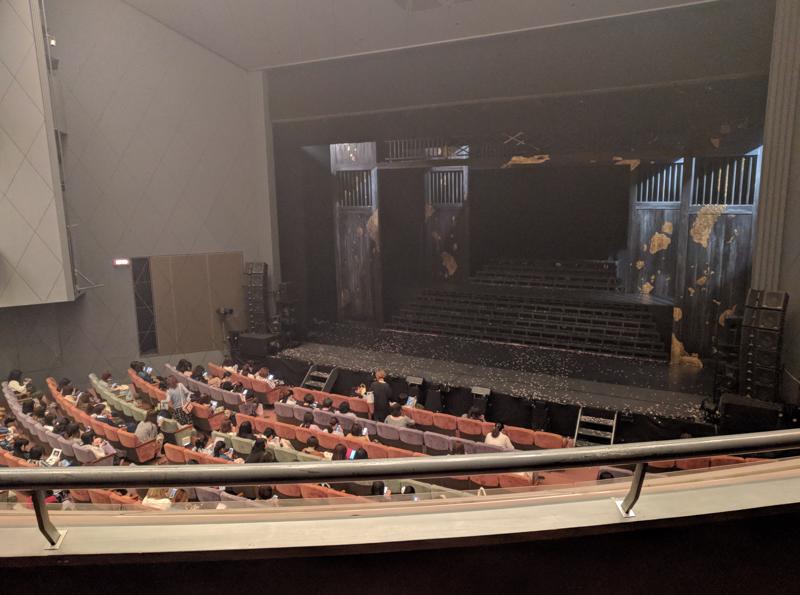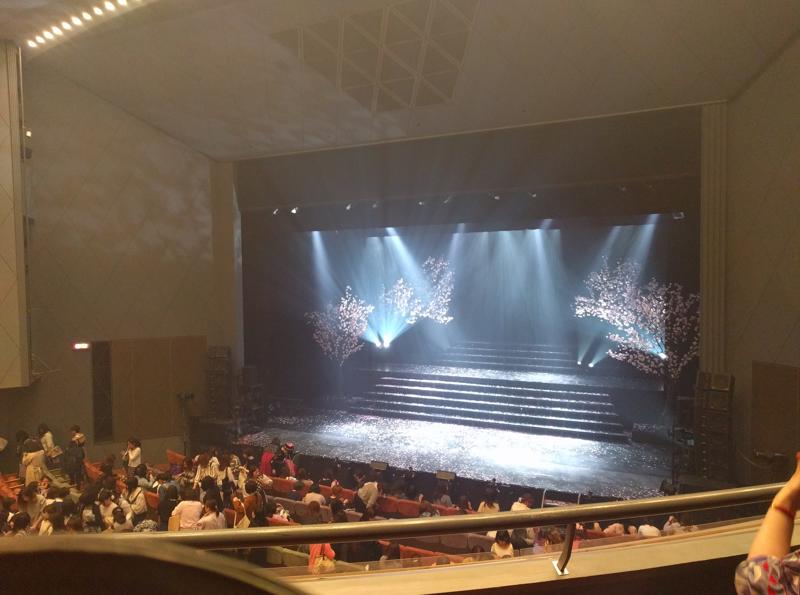Japan, Take 2
Ok, one more theatre review coming up. For the month of April I saw a total of 7 live theatrical productions (2 of those were the Super Kabuki), and I am committed to doing brief reviews for each one, so I can remember these experiences.
The Hakuouki Musical (this original IP was an "Otome" dating simulator game. It then was turned into an anime. I am unfamiliar with either of these.) was actually the first 2.5D musical I was able to obtain a ticket for, and by which I discovered the ticket lottery system for these types of shows. For some reason, I was able to submit 2 entries to try and get a ticket, and I chose a weekend matinée and a weekday matinée. I won the weekday matinée.
This performance happened in Kobe, where I deemed was close enough to take the train to. The Shin Kobe Oriental Theatre was not a giant venue, and despite my seat being on the Mezzanine level,
April 20-24 葭始生 The First Reeds Grow
April 23, 2018
|
Kobe
Ok, one more theatre review coming up. For the month of April I saw a total of 7 live theatrical productions (2 of those were the Super Kabuki), and I am committed to doing brief reviews for each one, so I can remember these experiences.
The Hakuouki Musical (this original IP was an "Otome" dating simulator game. It then was turned into an anime. I am unfamiliar with either of these.) was actually the first 2.5D musical I was able to obtain a ticket for, and by which I discovered the ticket lottery system for these types of shows. For some reason, I was able to submit 2 entries to try and get a ticket, and I chose a weekend matinée and a weekday matinée. I won the weekday matinée.
This performance happened in Kobe, where I deemed was close enough to take the train to. The Shin Kobe Oriental Theatre was not a giant venue, and despite my seat being on the Mezzanine level,

I did not feel I would have needed binoculars to see the actors' faces. One interesting thing about this venue was that the souvenir goods were sold outside the theatre entrance (in the dead mall), so one didn't need to have a show ticket to purchase the goods.
This production did NOT have a rotating stage.
It did, however, consist of a large flight of stairs with two landings, so there were still plenty of levels available for the imminent sword fights. It did not have a painted backdrop, and the stairs and flys flanking the stage were all black, with gold paint accent splashes. This was a fairly minimalistic set. There were lights aimed out into the audience from underneath the stairs set, so there were moments where audience-blinding happened, even for my seat in the Mezzanine.
Immediately off the top of the show, petals fell onto the stage. In fact,

they would continue to fall throughout, accenting emotional beats, as proxy for blood splatter, and were not cleaned up during the (brief 15 min) intermission. From a practical theatre view, that is a fairly dangerous choice, as the petals are a huge slip hazard for a combat heavy show. However, the majority of the actors wore Tabi shoes with the rubber soles, which would help with traction but not break the illusion that they were in socks and sandals. In fact, the white tabi shoes had geta straps painted on top, so from afar, they looked fairly decent. The only character who wore actual zori was the father figure, as all he needed to do was walk on stage and walk off stage.
One of the characters was dressed as a "typical ninja in black", and constantly leapt from landing to landing in all his entrances and exits.
I was very impressed with the physical prowess off all the performers, as many of the ensemble would do flips and single-hand cartwheels to simulate and enhance their sword battles. This show also had 18+ people sword combats onstage, and the stair set displayed these fights like the display of dolls at Hinamatsuri.
There was constant background music accompaniment throughout the show, and music always enhances the emotional experience. If one can understand the dialogue language. Oddly enough, this was the first performance where I wanted earplugs. That was not (necessarily) a jab at the singing abilities of these ikemen actors-cast-for-their-looks, but it was just a tad too loud for me in that space.
The souvenir show program had all the characters in their costumes from the final act of the show, and since I didn't know who any of these characters were, for most of the show, I had no idea which actor corresponded with which photo from the book. I was surprised to see the photographed costumes in the printed book were the actual stage costumes, evident from the cheaply-made gold accent borders on the jackets, meant for easy maintenance, not for photorealism. In a surprisingly jarring moment for me, the main antagonist had to fight in his kimono, and in order to actually be able to move, he took long enough strides and turns that his kimono had to open up and his legs became visible. Of course he had white shorts on underneath, but it somehow really shocked me to see LEGS.
There was also an odd point where the lead had to travel up and down the stairs, but had to hike up his hakama as to not trip, and it looked more like he was grabbing his crotch.
This production also had the odd honour of being the first to have a female cast member. She was the audience proxy, as once again, the majority if not entirety of the audience was female. There was a

scene where the leads "kissed", and I was pleased to note that he did NOT crank her head back as to snap her neck when he moved her head back to kiss her, unlike the Takarazuka show.
I have already purchased the Live-viewing ticket for this show, as I want to see if this is a production worth my investment in the DVD for future study.
1.
Foreword
2.
72 Seasons of Japan: 雪下出麦 Beneath the Snow the Wheat Sprouts (January 1-5)
3.
Pheasants are like peacocks, right? 雉始雊 The Pheasant's First Calls (January 16-20)
4.
January 21-24 款冬華 The Butterbur flowers
5.
January 25-29 水沢腹堅 Mountain Streams Freeze
6.
January 30-February 3 鶏始乳 The Hens start laying eggs
7.
February 4-8 東風解凍 Spring winds thaw the ice
8.
February 9-13 黄鶯睍睆 The Nightingale Sings
9.
February 14-18 魚上氷 Fish Rise from the Ice
10.
February 19-23 土脉潤起 The Earth becomes Damp
11.
February 24-28 霞始靆 Haze First Covers the Sky
12.
March 1–5 草木萌動 Plants Show First Buds
13.
March 6–10 蟄虫啓戸 Hibernating Creatures Open their Doors
14.
March 11–15 桃始笑 The First Peach Blossoms
15.
March 16–20 菜虫化蝶 Leaf Insects become Butterflies
16.
March 21-25 雀始巣 The Sparrow Builds her Nest
17.
March 26-30 櫻始開 The First Cherry Blossoms
18.
March 31-April 4 雷乃発声 Thunder Raises its Voice
19.
April 5-9 玄鳥至 The Swallows Arrive
20.
April 10-14 鴻雁北 Geese Fly North
21.
April 15-19 虹始見 The First Rainbow Appears
22.
April 20-24 葭始生 The First Reeds Grow
23.
April 25-29 霜止出苗 The Frost Stops; The Rice Grows
24.
April 30- May 4 牡丹華 The Tree Peony Flowers
25.
May 5-9 蛙始鳴 The First Frogs Call
26.
May 10-14 蚯蚓出 The Earth Worms Rise
27.
May 15-20 竹笋生 Bamboo Shoots Appear
28.
May 21-25 蚕起食桑 The Silk Worm Awakes and Eats the Mulberry
29.
May 26-30 紅花栄 The Safflower Blossoms
30.
May 31-June 5 麦秋至 The Time for Wheat
31.
June 5 - June 9 蟷螂生 The Praying Mantis Hatches
32.
June 10 - 15 腐草為螢 Fireflies rise from the Rotten Grass
33.
June 16 - 20 梅子黄 The Plums turn Yellow
34.
June 21 - June 25 乃東枯 The common Self-Heal Dries (Summer Solstice)
35.
June 26 - June 30 菖蒲華 The Iris Flowers
36.
July 1 - July 6 半夏生 The Crow-dipper Sprouts
37.
July 7 - July 11 温風至 Hot Winds Blow
38.
July 12 - July 16 蓮始開 The First Lotus Blossoms
39.
July 17 - July 21 鷹乃学習 The Young Hawk Learns to Fly
40.
July 22 - July 27 桐始結花 The First Paulownia Fruit Ripen
41.
July 28 - Aug 1 土潤溽暑 Damp Earth Humid Heat (Major Heat)
42.
Aug 2 - Aug 6 大雨時行 Heavy Rain Showers
43.
Aug 7 - Aug 11 涼風至 A cool Wind blows (First Autumn)
44.
Aug 12 - Aug 16 寒蝉鳴 The Evening Cicada Sings
45.
Aug 17 - Aug 22 蒙霧升降 Thick Fog Blankets the Sky
46.
Aug 23 - Aug 27 綿柎開 The Cotton Lint Opens (Limit of Heat)
47.
Aug 28 - Sept 1 天地始粛 Earth & Sky Begin to Cool
48.
Sept 2 - Sept 6 禾乃登 The Rice Ripens
49.
Sept 7 - Sept 11 草露白 Dew Glistens White on Grass
50.
Sept 12 - Sept 16 鶺鴒鳴 Wagtails Sing
51.
Sept 17 - Sept 21 玄鳥去 Swallows Leave
52.
Sept 22 - Sept 27 雷乃収声 Thunder Ceases (Autumn Equinox)
53.
Sept 28 - Oct 2 蟄虫坏戸 Insects hole up Underground
54.
Oct 3 - Oct 7 水始涸 Farmers Drain Fields
55.
Oct 8 - Oct 12 鴻雁来 The Geese Arrive
56.
November 19
Share your travel adventures like this!
Create your own travel blog in one step
Share with friends and family to follow your journey
Easy set up, no technical knowledge needed and unlimited storage!